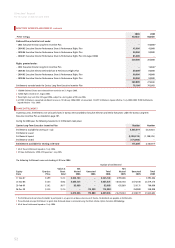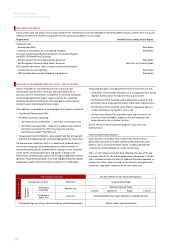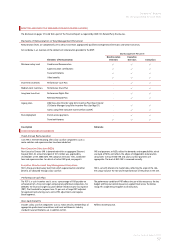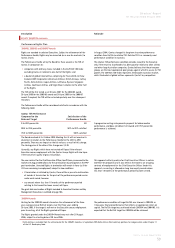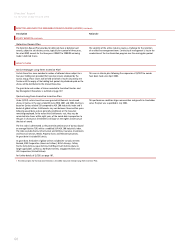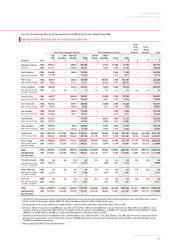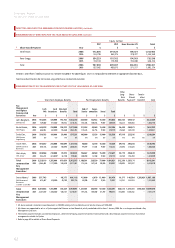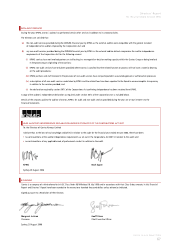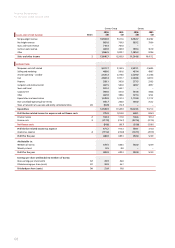Qantas 2006 Annual Report Download - page 61
Download and view the complete annual report
Please find page 61 of the 2006 Qantas annual report below. You can navigate through the pages in the report by either clicking on the pages listed below, or by using the keyword search tool below to find specific information within the annual report.
59
Qantas Annual Report 2006
Directors’ Report
for the year ended 30 June 2006
Description Rationale
EQUITY BENEFITS CONTINUED
Performance Rights Plan
2004/05, 2005/06 and 2006/07 Awards
Rights are awarded to selected Executives. Subject to achievement of the
Performance Hurdle, Rights may be converted (on a one-for-one basis) to
Qantas shares.
The Performance Hurdle set by the Board for these awards is the TSR of
Qantas in comparison to:
• companies with ordinary shares included in the S&P/ASX 100 Index
excluding Qantas in relation to one-half of the Rights; and
• a basket of global listed airlines comprising Air France-KLM, Air New
Zealand, AMR Corporation (American Airlines), British Airways, Cathay
Pacific, Delta Airlines1, Japan Airlines, Lufthansa, Ryanair, Singapore
Airlines, Southwest Airlines and Virgin Blue in relation to the other half
of the Rights.
The TSR will be fi rst tested as at 30 June 2007 for the 2004/05 award,
30 June 2008 for the 2005/06 award and 30 June 2009 for the 2006/07
award. If required, the TSR will be re-tested quarterly over the subsequent
two years.
In August 2004, Qantas changed its long-term incentive performance
condition from RoTGA to relative TSR. Relative TSR is a commonly used
performance condition in Australia.
The relative TSR performance condition provides reward to the Executive
only if the return to shareholders has been positive relative to other airlines
and other large Australian companies. Qantas believes that these two peer
groups are the most appropriate peer groups against which to assess its TSR
growth. The S&P/ASX 100 Index represents the broader Australian market,
whilst the basket of global airlines represents Qantas’ key competitors.
The Performance Hurdle will be considered satisfied in accordance with the
following table:
Qantas TSR Performance
Compared to the Satisfaction of the
Relevant Target Performance Hurdle
0 to 49th percentile Nil
50th to 74th percentile 50% to 99% satisfied
75th to 100th percentile 100% satisfied
A progressive vesting scale prevents payment for below median
performance, and does not deliver full reward until 75th percentile
performance is achieved.
The Board resolved at its October 2005 Meeting that it will not exercise its
discretion in relation to the Performance Hurdle for the 25th to 49th
percentile. There was no impact on the fair value as a result of this change.
The closing price at the date of this change was $3.38.
Generally, any Rights which have not vested will lapse if the relevant
Executive ceases employment with the Qantas Group. Rights will also lapse
if the Executive is guilty of gross misconduct.
The new contract for the Chief Executive Offi cer, Geoff Dixon, announced to the
market on 8 August 2006 allows for the continuation of participation in the PRP
post termination. Unvested Rights at termination will remain in force (as if the
CEO was remaining in employment) subject to two conditions:
• if termination is initiated by Qantas, there will be a pro-rata continuation
of awards at termination for the parts of the performance period service
under each award; however
• any awards where less than 18 months of the performance period
relating to that award has been served, will lapse.
The grant date and number of Rights awarded to Executive Directors and Key
Management Executives is outlined on page 106.
This approach reflects practice for Chief Executive Officers in certain
S&P/ASX 50 companies and it also reflects the move to an on-going
contract of employment for the Chief Executive Officer. Under this
approach, no vesting is allowed on long term equity awards where
less than 18 months of the performance period has been served.
2003/04 Awards
Vesting for the 2003/04 award is based on the achievement of the three
year average annual RoTGA targets over the three years ending
30 June 2006. If the target is not met or the Executive ceases employment
prior to vesting, all of the Rights granted will lapse.
The Rights granted under the 2003/04 Award may vest after 28 August
2006, subject to a testing date of 30 June 2006.
The performance condition of target RoTGA was chosen in 2003/04 as
it measures financial performance that reflects an appropriate return on
capital. The RoTGA target was achieved in both 2003/04 and 2004/05. It is
expected that the RoTGA target for 2005/06 will be achieved.
1 Delta Airlines is excluded from the airline basket for the 2006/07 Award as in September 2005 Delta Airlines filed voluntary petitions for reorganisation under Chapter 11
of the U.S. Bankruptcy Code.





